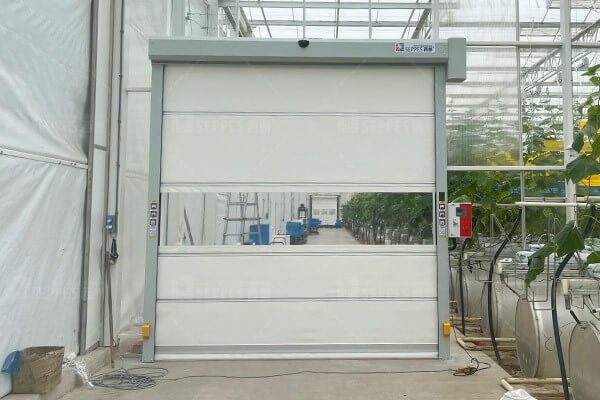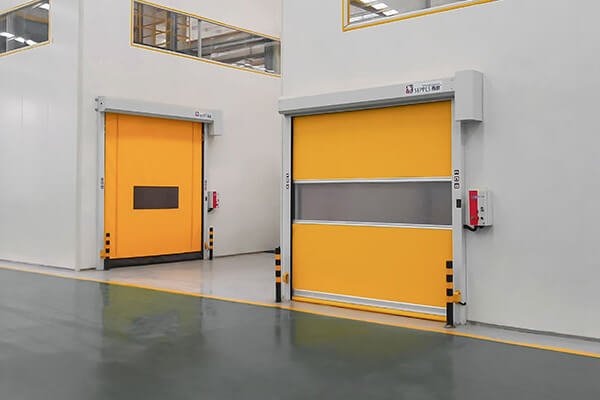
In commercial and industrial environments, space management is critical. Traditional room dividers, such as walls and sliding doors, often suffer from a number of limitations. hindering flexibility, taking up valuable space and limiting accessibility. But thanks to the revolutionary solution of rapid door offering unrivaled versatility and efficiency. These problems are now solved!
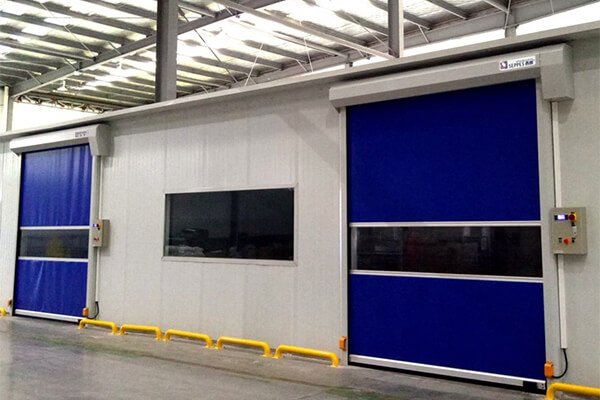
Challenges associated with Traditional Room Dividers
Traditional room dividers such as walls, industrial sliding doors and partitions have long been used to divide space in a variety of environments – from homes and offices to commercial and industrial facilities. Unfortunately, however, traditional partitions come with their own set of challenges. It may limit their effectiveness or usability. Here are a few common problems associated with traditional room dividers:
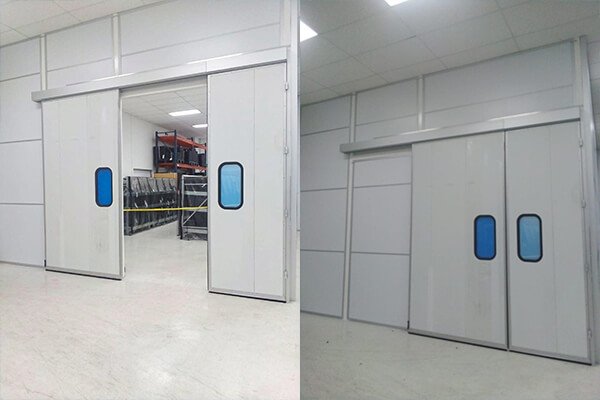
Limited Flexibility: Walls and partitions that cannot be easily reconfigured to accommodate changing spatial needs create permanent barriers. Hinder adaptability of interior layouts. Makes it difficult to meet changing needs such as reorganization, expansion or repurposing of space. This limits the adaptability of interior layouts.
Lack of privacy and soundproofing: While walls and partitions can protect privacy by physically separating spaces. However, they may not provide adequate soundproofing, especially in environments with high noise levels. Gaps and seams in sliding doors and partitions may allow sound to pass through. This affects privacy and distracts occupants of neighboring areas.
Restricted access: Sliding doors and partitions require opening and closing gaps. This restricts access and impedes movement between partitioned areas. Requirements for swinging or sliding clearances can further impede access to these spaces. This restricts users from moving between areas separated by partitions.
Advantages of Rapid Door

The advantages of rapid doors are manifold. There are a range of benefits that make them ideal for a variety of applications in commercial, industrial and institutional environments. Below are some of the key benefits:
Rapid Operation: As the name suggests, high speed roller doors can be opened and closed quickly to improve workflow efficiency in busy environments. Examples include high-traffic warehouses or manufacturing facilities. Their fast opening/closing times allow people, vehicles and materials to move quickly through the doorway without having to wait, further increasing productivity.
Space saving: High speed roller shutter doors can be rolled vertically into the ceiling when not in use, resulting in significant floor space savings. The most efficient use of floor space and better utilization of the surrounding area. Rolling doors are especially beneficial for facilities where space is limited or where effective space management is a must.
Improved traffic flow: Rapid roller doors help to create a smooth flow of traffic within a facility. From production areas of a factory to climate-controlled storage warehouses. High-speed rolling doors allow for the unimpeded movement of people, equipment and goods. This further reduces traffic congestion and accidents or collisions in high-traffic environments.
Energy Efficiency: Many high-speed rolling doors are designed to maximize energy efficiency with energy-saving features such as insulated door curtain materials and airtight seals. Reducing heat loss or gain between climate-controlled spaces reduces heating, cooling and ventilation energy consumption. Maintaining more consistent indoor temperatures contributes to energy efficiency.
Durability and Reliability: Rapid roll up doors are designed to withstand the rigors of industrial and commercial environments. Constructed of resilient materials such as steel or aluminum, they are designed for frequent use and harsh operating conditions. With proper care, maintenance and necessary repairs. High-speed roll-up doors can be a long-term investment in a facility’s infrastructure.
Applicable Scenarios and Industries
From warehouse facilities to manufacturing plants, high speed roll up doors are used in a variety of situations and industries, proving their versatility. Warehouse facilities can use them to separate storage areas while still allowing easy access for forklifts and personnel. Manufacturing plants, on the other hand, can use them to create designated work areas without impeding the flow of machinery or materials. They can even be used in retail environments. Providing an uninterrupted flow of customers while separating different areas, automotive repair shops or food processing plants can also benefit!

Choosing an Appropriate Rapid Door
Choosing the ideal high speed door requires careful consideration of many factors. These include the size of the compartmentalized space, frequency of use, and environmental conditions such as temperature and humidity. Factors such as materials, insulation and optional features such as remote control operation must also be evaluated in relation to specific requirements and operational preferences. to ensure a match with specific requirements and operational preferences. Consulting with an experienced professional is key to selecting the best door solution. This will maximize space management.
Installation and Maintenance
Installation and ongoing maintenance are both key factors in optimizing the performance and longevity of your fast action door. Helping to ensure maximum functionality and longevity. Professional installation ensures proper calibration and function. And routine tasks such as cleaning, lubrication and inspection help prevent problems while extending service life. By adhering to recommended maintenance practices. Businesses can reduce downtime while ensuring their speed shutter doors continue to operate effectively.
Cost-Benefit Analysis
A cost-benefit analysis looks at the costs and benefits associated with each option. It provides businesses with an important way of assessing the financial impact of investing in a high speed roller shutter door versus a traditional room divider. By understanding which solution best meets their specific requirements. Businesses can make an informed decision on which solution will be more cost effective for them. Below is a summary of the cost-benefit analysis of a high speed roller shutter door:
Costs
Initial Investment: Rapid door typically has a higher initial cost compared to more traditional room dividers such as wall or sliding doors (e.g., wall and sliding doors). The cost depends on factors such as the size of these doors, material composition, desired features, and installation requirements.
Installing a high speed rolling door adds to the cost: Installing a high speed rolling door requires consideration of additional costs for labor, equipment, and materials. A professional installer should be preferred to ensure proper alignment, functionality and compliance with safety standards.
Maintenance Costs: While speed shutter doors tend to be durable and low maintenance, there may be occasional costs incurred during routine tasks. Such as cleaning, lubricating, inspecting parts, or repairing or replacing when damage occurs.
Energy Costs: High-speed rolling doors can save energy by limiting heat loss or gain between different spaces. However, energy costs may be incurred when operating a motorized door in a high use environment.
Benefits
Optimization of space: The rapid door has a space-saving design. It can be rolled vertically into the ceiling when not in use, thus optimizing the use of floor space. This saves money by eliminating larger floor areas or additional storage requirements.
Increased efficiency: Rapid door feature fast opening and closing. It promotes smooth traffic between different spaces, increasing operational efficiency and productivity. Reducing wait times for people, vehicles and materials saves time while increasing throughput.
Energy Efficiency: High speed roll up doors equipped with insulating curtain material and airtight seals can improve energy efficiency by limiting heat loss or gain between climate-controlled spaces. This reduces energy costs and minimizes long-term environmental impact.
Improved security: High speed rolling doors are often equipped with advanced security features. Such as high-strength door curtain materials, integrated locking systems and access control mechanisms. This helps to prevent unauthorized access, protect valuable assets and reduce the risk of theft or vandalism.
Real-World Case Studies
Real-life case studies provide concrete examples of the successful use of rapid doors across a wide range of industries and applications. Highlighting the transformative impact of high-speed rolling doors on efficiency, productivity and safety. Below are a few typical case studies:
Manufacturing Facility Optimization
Case Study: A large automotive parts plant was experiencing traffic congestion and workflow bottlenecks at entry/exit points. By installing rapid doors at key entrances and exits throughout the plant (loading docks and production areas). including the loading dock and production area, the high-speed roll-up doors helped streamline traffic flow. Wait times for trucks and people were reduced while overall productivity was increased through reduced idle time and smoother operations.

Cold Storage Warehouse Efficiency
Case Study: mes A perishable goods cold storage warehouse struggled to keep consistent temperatures and reduce energy costs as a result of constantly opening and closing traditional freezer doors. By switching to high speed roll up doors equipped with insulated curtain materials and airtight seals, however, significantly less heat loss was generated as energy consumption dropped while maintaining optimal temperature control, leading to cost savings on energy bills as well as improved product quality and shelf life.
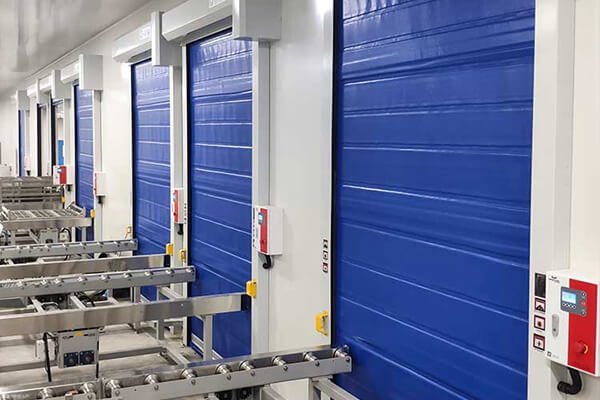
Frequently Asked Questions(FAQs)
1.How can I choose the right high speed roll up door for my specific space requirements?
When choosing a high speed door, consider the following factors:
- Size and Dimensions: Measure the width and height of the doorway to ensure compatibility with the door size.
- Material: Select a door material (e.g., fabric, steel, aluminum) based on durability, insulation, and environmental factors.
- Speed and Operation: Determine the desired opening and closing speed, as well as the type of operation (e.g., manual, motorized, remote-controlled).
- Features: Consider additional features such as insulation, vision panels, wind resistance, and safety sensors based on specific requirements and preferences.
- Installation Requirements: Assess installation considerations such as mounting options, space constraints, and electrical requirements.
- Budget: Evaluate cost considerations including initial investment, installation costs, and long-term maintenance expenses.
2.How long does the installation process for rapid doors typically take?
The installation process for high speed rolling doors can vary depending on factors such as door size, complexity, and site conditions. Generally, installation can be completed within a day to a few days for standard-sized doors. Larger or more intricate installations may require additional time for assembly, mounting, wiring, and testing to ensure proper functionality and alignment.
3.What maintenance practices are recommended to ensure the longevity of rapid door?
To ensure the longevity and optimal performance of high speed doors, follow these maintenance practices:
- Regularly inspect door components for signs of wear or damage.
- Keep door tracks and guides clean and free of debris.
- Lubricate moving parts such as rollers and hinges to reduce friction.
- Check and adjust tension on door springs as needed.
- Address any issues or malfunctions promptly to prevent further damage.
4.How do the cost savings from space optimization compare to the investment costs of Rapid doors?
The cost savings from space optimization achieved through high-speed roll-up doors can significantly offset the initial investment costs. By maximizing floor space utilization and improving workflow efficiency, businesses can reduce the need for larger facilities, additional storage space, or costly renovations. Over time, the cost savings from space optimization can outweigh the investment costs of high-speed roll-up doors, making them a financially viable solution for long-term space management and operational efficiency.
